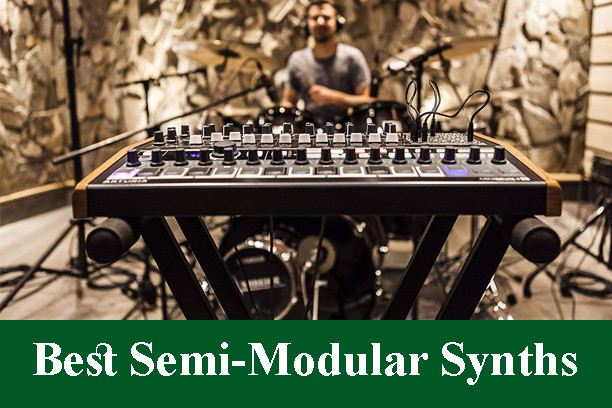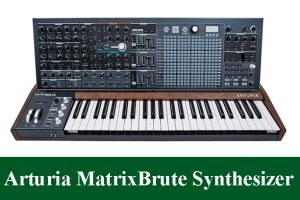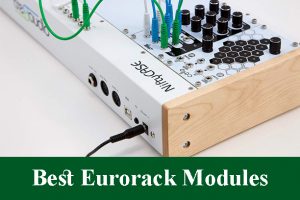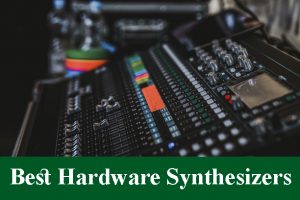Top Semi-Modular Synths Reviews (Updated)
Semi-modular synthesizers are the same old thing – any semblance of Moog, Arp, Buchla and more were creating patchable simple instruments all through the ’70s and ’80s.
Be that as it may, with the ongoing ascent in prominence of Eurorack modular combination, and the ongoing pattern for reasonable simple instruments, CV-prepared, re-routable synthesizers are particularly back in fashion.
The uplifting news is, you never again need to remortgage your home to get into the semi-modular game. As you’ll see from our gather together, there are a lot of extraordinary equipment synths accessible at all cost focuses; from spending work area modules to far reaching keyboards and sequencer-prepared brutes!
Regardless of whether you need simple genuineness, something novel and recondite, or an advanced bleeding edge synth, there’s options out there to consider every contingency, with heaps of degree to grow things by fixing in outside apparatus or Eurorack modules. So what’s the best semi-modular out the in 2018? Peruse on to discover…
3 Top Semi-Modular Synthesizers
Pittsburgh Modular Microvolt 3900 Semi-modular Analog Synthesizer
Polyphony: Mono | Synth motor: Single VCO with PWM, four synchronous waveforms and wavefolding | Control: 32-note keyboard, sequencer/arp | Patch focuses: 39 | Other I/O: MIDI, ace out, headphone out
- Pros
- Double mode VCA gives a shifted sonic character
- Binary channel can be both smooth and gritty
- Cons
- No arrangement saving
- Bi-directional channel resonance can be confusing from the start
As a total bundle, there’s a ton to like about the Microvolt. Its patchbay may do not have the broad fixing options of, state, the MiniBrute 2 or even Behringer Neutron, yet it has an inclination that it’s been painstakingly designed to offer precisely the apparatuses expected to capitalize on its fascinating synth motor. Likewise with the Make Noise 0-Coast, the combination of traditional subtractive and ‘West Coast’ amalgamation devices makes the Microvolt truly energizing to explore different avenues regarding. The misleadingly profound modulation sources and MIDI to CV apparatuses add to this as well. Pittsburgh Modular portrays the Microvolt as “an adoration letter to the simple monosynth” and that feels genuinely able. Sonically it touches on a tad bit of the adjusted unusual quality of the Arp Odyssey, the imaginative surfaces of Buchla’s Music Easel and even the punchy bass hints of the SH-101, all while keeping up its very own character.
Moog Grandmother Semi-Modular Analog Keyboard Synthesizer
Polyphony: Mono | Synth motor: 2 VCO, 2 VCF (24db LPF and 6db HPF), VCA, 1 ENV (ADSR), 1 LFO, spring reverb | Control: 32-note keyboard, sequencer/arp | Patch focuses: 41 | Other I/O: MIDI in, out and through, sound in, ace out, headphone out, arp/seq CV control
- Pros
- Adaptable, patchable design
- Loads of interconnectivity
- Classic Moog modular sound!
- Cons
- Some functions are covered up and not self-evident
Moog’s most recent semi-modular comes outfitted with a 32-note Fatar keyboard, sequencer and arp, making it more execution focussed than its kin in the Mother line. It has a chic multi-shaded retro design that suits its bona fide vintage sound. The old-school approach is adjusted pleasantly with the inclusion of a spring reverb module – an uncommon inclusion in present day synths. Grandma is an adaptable entertainer, equipped for a huge scope of sounds even before fixing a link. Is it worth the asking cost? Completely, if for no other explanation than giving clients a sample of those old Moog modular circuits without taking out a second home loan.
Korg MS20 Mini Semi-Modular Analog Synthesizer
Polyphony: Mono | Synth motor: All-simple; 2 VCO, 2 VFC (12db LFP and HPF), VCA, 2 EG (ADR and AHDSR), 1 LFO | Control: 3-octave smaller than normal keyboard | Patch focuses: 33, including outside sign processor | Other I/O: MIDI in, USB MIDI in, ace out, headphone out
- Pros
- Another, yet littler, MS-20
- MIDI/USB-furnished with smaller than normal jack patchbay
- Super affordable
- Cons
- Patchbay isn’t ideally configured for use with Eurorack
The Korg MS-20 was initially propelled in 1978 (discontinued in 1983) and is absolutely one of the most iconic monosynths all things considered. At first viewed as a poor man’s ARP 2600 as a result of its comparative semi-modular design, it soon turned into a religion great inside electronic music hovers, generally because of its adaptable double channels which empower the simple creation of wound sounds, executioner FX, drum hits and staple leads and basses. Korg’s 2013 re-issue is 66% the size of the first, however beyond that it works superbly of reproducing the sound and feel of the MS-20 – at a fraction of the value the firsts go for second-hand.
8 Best Semi-Modular Synthesizers
Arturia MINIBRUTE 2S MIDI USB Desktop Analog Synthesizer/Step Sequencer
Polyphony: Mono | Synth motor: All-simple; 2 VCO, 1 VCF (12db multi-mode), VCA, 2 EG (AD and ADSR), 2 LFO | Control: 25-note keyboard (2 only), sequencer and arp | Patch focuses: 48, remembering outside sound for | Other I/O: MIDI in/out, USB (MIDI in/out), ace out, headphone
- Pros
- Patchbay makes version 2 considerably more adaptable than the original
- The 2S sequencer is very impressive
- Can interface with an entire host of outside gear
- Cons
- Single – 12dB VCF does not have a touch of adaptability
The first MiniBrute was a genuinely clear monosynth with a couple of interesting touches and some CV control, yet version 2 is completely semi-modular, flaunting an expanded synth motor and a far reaching smaller than normal jack patchbay. The MiniBrute additionally now comes in two assortments: the standard keyboard version, presently furnished with a Keystep-style sequencer, and the 2S, which swaps the keys for a cushion based advance sequencer like the BeatStep. While both feature a sequencer and arp with yields that can be fixed and steered to outer rigging, the 2S goes further on this front with bunches of incredible CV and modulation control that makes it the ideal base for a bigger modular apparatus. In the event that growing your semi-modular into full Eurorack region is your objective, have a go at blending a MiniBrute 2 with Arturia’s good RackBrute case for a smooth, portable arrangement.
Behringer NEUTRON Paraphonic Analog and Semi-Modular Synthesizer w/Splliter
Polyphony: Paraphonic | Synth motor: all-simple; 2 VCO, 1 VCF (12db LPF/HPF), VCA, 2 ENV (ADSR), LFO, BBD delay, overdrive | Control: External MIDI/CV control only | Patch focuses: 56 | Other I/O: MIDI In/Thru, USB (MIDI in), ace out, sound in, headphone out
- Pros
- Incredible incentive for money
- 3340 VCO – a clone of the unbelievable CEM3340 found in simple works of art of the late ’70s and mid ’80s
- Flexible patchbay
- Cons
- Too simple to soak the channel section
Behringer’s synth business may be most popular for their controversy-pursuing ‘tributes’, yet the German brand likewise have two or three fantastic unique instruments added to their repertoire. Following in the means of a year ago’s Deepmind, Neutron is a simple semi-modular that packs in a great deal of adaptability at its truly moderate cost point. The Neutron has a couple of blemishes and there are some disappointing design issues yet it sounds great, and regarding value for-your-money, it’s a serious take. While it does a generally excellent activity at making increasingly reasonable sounds, it additionally exceeds expectations at the unusual and wonderful. Behringer may very well have a champ on its hands.
Moog Mother-32 Semi Modular Analog Synthesizer
Polyphony: Mono | Synth motor: All-simple; 1 VCO, 1 VCF (24db LPF/HPF), VCA, 1 ENV (ASD), 1 LFO | Control: 13-note button keyboard/32-advance sequencer | Patch focuses: 32, including outside sound information | Other I/O: MIDI in, ace out
- Pros
- Great value
- Punchy, looked for after ‘Moog’ sound
- Works extraordinary with other modular gear
- Cons
- Just a solitary VCO, ENV and LFO
With only a solitary oscillator and genuinely fundamental modulation sources, Moog’s Mother-32 may look a little under-fueled contrasted with its semi-modular adversaries, however a convenient fix cove and magnificent sounding components give it more punch than you may anticipate. In the case of nothing else, it offers the least expensive approach to get that great ‘Moog sound’ – and the sound in lets your course flags through its flawless sounding stepping stool channel. It’s capacity to play pleasantly with other semi-modular and Eurorack gear makes it exceptionally expandable as well. Conceivably, this is an incredible portal into the universe of modular amalgamation for those hoping to dunk their toes in the water just because. So be cautioned – getting one may lead you to acquiring another two, and afterward dishing out on a full Eurorack rig. It’s a tricky slant…
Moog DFAM Semi-Modular Analog Percussion Synthesizer
Polyphony: Mono | Control: 2-channel 8-advance sequencer | Patch focuses: 24, including outer sound info | Other I/O: Master out
- Pros
- One of a kind sound motor fit for flawless, punchy percussion and rich basses
- Patchbay opens a lot of new roads, and is incredible when snared to outside gear
- Cons
- Lack of MIDI is a deterrent for studio and live use
- Sequencer is extremely fundamental
Like its kin the Mother-32, DFAM (or Drummer From Another Mother) is a semi-modular equipment instrument that consolidates exemplary simple synth components with an inherent sequencer and Eurorack-accommodating patchbay. Be that as it may, where the Mother-32 is an exemplary monosynth design, DFAM is progressively elusive, designed to work in electronic percussion, atonal surfaces and punchy synth sounds. It’s extraordinary at what it does – making extremely exceptional percussive sounds, punchy synth bass hits and intriguing FX. With no MIDI information however, DFAM is progressively similar to an addendum to the Mother-32 biological system – or an accomplice for a current Eurorack framework – than a standalone studio instrument.
Make Noise 0-Coast
Polyphony: Mono | Patch focuses: 27 remembering outside sound for | Other I/O: 2x MIDI in (MIDI to CV and MIDI to entryway), headphone/line out
- Pros
- High quality
- Handy size
- Unique design
- Cons
- Novices should get their work done
North Carolina-based outfit Make Noise is known for making portable frameworks that movement amazingly well yet still give incredible innovative profundity. Enter the 0-Coast, or ‘No Coast’ as it is pronounced.Designed to imitate the sensibilities of both the Moog and Buchla/Serge universes, this minimized bit of unit is about the size of a tablet PC, yet still packs in an enormous measure of sonic creation and manipulation options at a clean cost. Make Noise never appears to flop on building hardware that conveys both personality and profundity. The nuances of dialing in overtones and afterward filling them out with the Multiply circuit carry a lot of variation to the table. 0-Coast is maybe somewhat more intricate to get your head around than some in this gather together, however it merits the speculation of time.
Analogue Solutions Fusebox Synthesizer
Polyphony: Mono | Synth motor: All simple; 3 VCO + sub oscillator, 1 VCF (12db low/high/band/indent), VCA, 2 ENV (AD/RS), 1 LFO | Control: Arpeggiator, Patternator sequencer, Interval Generator | Other I/O: MIDI in, out and through, ace out
- Pros
- Adaptable fixing and steering options
- The Patternator is a novel sequencing tool
- Great sounding simple synth engine
- Cons
- Some sound seep between synth sections
Fusebox is a three-oscillator monosynth which utilizes completely simple hardware for every one of its sounds generation, modulation and interior control functions. The only design perspective that recognizes the digital age is the inclusion of a MIDI interface that creates a scope of CV and door signals from the outer world. It additionally features a few onboard generators, including the Patternator, which is a fascinating combination of CV and door sequencing sources. The Fusebox is an extraordinary sounding synth in its own right, yet include this example generation, along with the arpeggiator, MIDI control and fixing and it assumes a personality and style a whole lot its own. Certainly justified regardless of a look!
Dreadbox Nyx V2 Paraphonic Analog Synthesizer with Reverb
Polyphony: Paraphonic | Control: External MIDI/CV only | Other IO: MIDI in and through, sound in, ace out
- Pros
- Rich, characterful sound
- Compact and simple to use
- Great reverb
- Cons
- Not the most adaptable instrument at this value point
Athens-based brand Dreadbox have been relentlessly growing their contribution of equipment synths in the previous scarcely any years, and earning attention with amazing simple instruments like the – presently discontinued – Hades bass synth and their Abyss poly. NYX is one of a few semi-modular work area synths in their range, which develops its punchy, rich synth motor with a little however successful patchbay. The genuine feature here, in any case, is the included reverb, which comes graciousness of pedal brand Crazy Tube Circuits and includes a touch of lovely space and character. NYX probably won’t have the broad fixing options of different synths in this gather together, yet for its minimal size it has a not too bad measure of adaptability and a noteworthy full-bodied sound.
Roland System-1m Semi-Modular Plug-out Synthesizer with 1 Year EverythingMusic Extended Warranty Free
Polyphony: 4-voice | Synth motor (inward mode): 2 OSC, LPF, HPF, AMP, 3 ENV, LFO, Crusher, Reverb, Delay; (Plug-Out mode): Dependent on programming | Control: External MIDI/CV only | Patch focuses: 17 | Other I/O: MIDI in and out, 2x sound out, headphone out, USB (MIDI, sound and Plug-Out control)
- Pros
- Adaptable digital synth engine
- Interesting fixing capabilities
- Access to great Roland sounds
- Cons
- Interface has some readability/task issues
At its center, this is a keyboardless, rack-mountable version of Roland’s System-1 ‘Fitting out’ synth – a novel digital instrument with a synth motor that can be stacked with digital emulations of an assortment of Roland works of art. Here, be that as it may, we additionally get a variety of Eurorack-style fix focuses, which are an unordinary and profoundly charming inclusion for a digital polysynth. The fixing capacity works well overall, but with the limitation that sound-generation in this mode is monophonic. The new synth models accessible through the Plug-Out framework truly broaden the sonic extension, however there are a few trade offs here as far as control task for the front board. This is a decent sounding synth with a lot of adaptability, however it’s questionable what this’ identity is truly focused on. At last however, we compliment Roland for adopting another strategy to the simple versus digital discussion.















